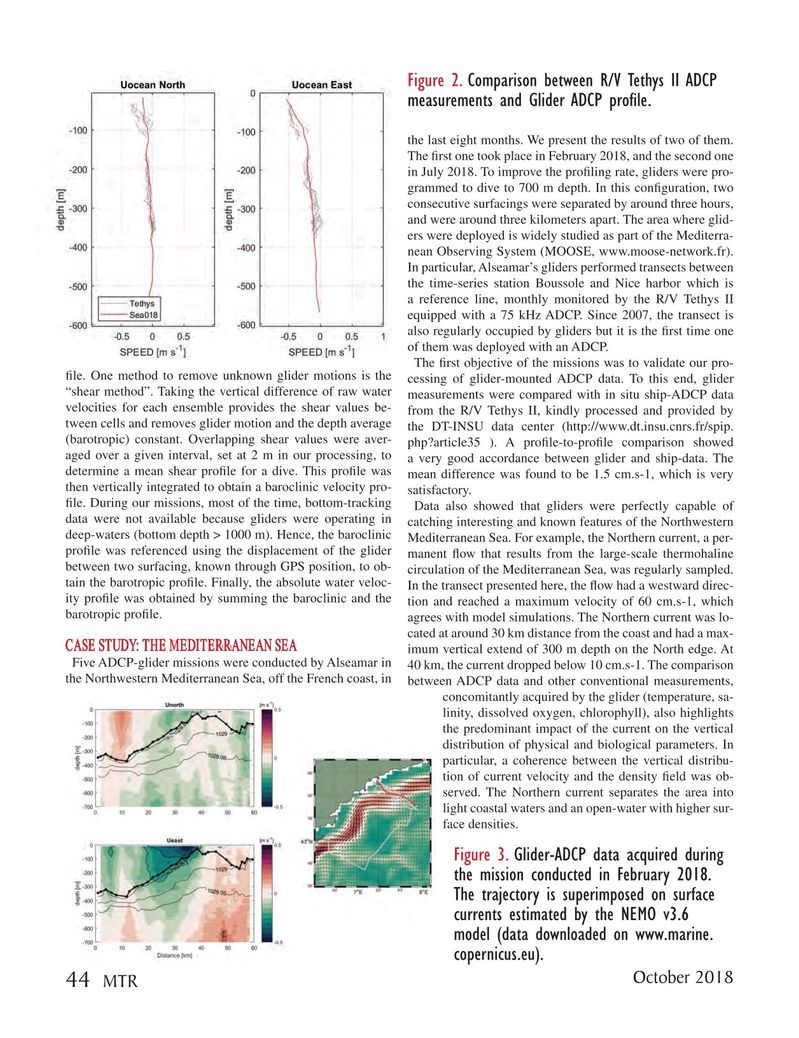
Page 44: of Marine Technology Magazine (October 2018)
Ocean Observation: Gliders, Buoys & Sub-Surface Networks
Read this page in Pdf, Flash or Html5 edition of October 2018 Marine Technology Magazine
Figure 2. Comparison between R/V Tethys II ADCP measurements and Glider ADCP pro? le.
the last eight months. We present the results of two of them.
The ? rst one took place in February 2018, and the second one in July 2018. To improve the pro? ling rate, gliders were pro- grammed to dive to 700 m depth. In this con? guration, two consecutive surfacings were separated by around three hours, and were around three kilometers apart. The area where glid- ers were deployed is widely studied as part of the Mediterra- nean Observing System (MOOSE, www.moose-network.fr).
In particular, Alseamar’s gliders performed transects between the time-series station Boussole and Nice harbor which is a reference line, monthly monitored by the R/V Tethys II equipped with a 75 kHz ADCP. Since 2007, the transect is also regularly occupied by gliders but it is the ? rst time one of them was deployed with an ADCP.
The ? rst objective of the missions was to validate our pro- ? le. One method to remove unknown glider motions is the cessing of glider-mounted ADCP data. To this end, glider “shear method”. Taking the vertical difference of raw water measurements were compared with in situ ship-ADCP data velocities for each ensemble provides the shear values be- from the R/V Tethys II, kindly processed and provided by tween cells and removes glider motion and the depth average the DT-INSU data center (http://www.dt.insu.cnrs.fr/spip.
(barotropic) constant. Overlapping shear values were aver- php?article35 ). A pro? le-to-pro? le comparison showed aged over a given interval, set at 2 m in our processing, to a very good accordance between glider and ship-data. The determine a mean shear pro? le for a dive. This pro? le was mean difference was found to be 1.5 cm.s-1, which is very then vertically integrated to obtain a baroclinic velocity pro- satisfactory. ? le. During our missions, most of the time, bottom-tracking
Data also showed that gliders were perfectly capable of data were not available because gliders were operating in catching interesting and known features of the Northwestern deep-waters (bottom depth > 1000 m). Hence, the baroclinic Mediterranean Sea. For example, the Northern current, a per- pro? le was referenced using the displacement of the glider manent ? ow that results from the large-scale thermohaline between two surfacing, known through GPS position, to ob- circulation of the Mediterranean Sea, was regularly sampled. tain the barotropic pro? le. Finally, the absolute water veloc-
In the transect presented here, the ? ow had a westward direc- ity pro? le was obtained by summing the baroclinic and the tion and reached a maximum velocity of 60 cm.s-1, which barotropic pro? le.
agrees with model simulations. The Northern current was lo- cated at around 30 km distance from the coast and had a max-
CASE STUDY: THE MEDITERRANEAN SEA imum vertical extend of 300 m depth on the North edge. At
Five ADCP-glider missions were conducted by Alseamar in 40 km, the current dropped below 10 cm.s-1. The comparison the Northwestern Mediterranean Sea, off the French coast, in between ADCP data and other conventional measurements, concomitantly acquired by the glider (temperature, sa- linity, dissolved oxygen, chlorophyll), also highlights the predominant impact of the current on the vertical distribution of physical and biological parameters. In particular, a coherence between the vertical distribu- tion of current velocity and the density ? eld was ob- served. The Northern current separates the area into light coastal waters and an open-water with higher sur- face densities.
Figure 3. Glider-ADCP data acquired during the mission conducted in February 2018.
The trajectory is superimposed on surface currents estimated by the NEMO v3.6 model (data downloaded on www.marine.
copernicus.eu).
October 2018 44
MTR
MTR #8 (34-49).indd 44 MTR #8 (34-49).indd 44 9/26/2018 4:40:35 PM9/26/2018 4:40:35 PM

 43
43

 45
45
